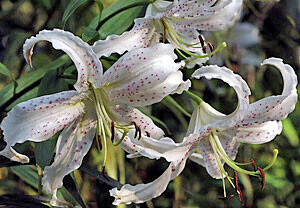
You’ve eaten all the eggs and chocolate bunnies you can handle and the only thing left is that Easter Lily you received as a gift. You begin to wonder, “Now what do I do?” After blooming, Easter Lilies (Lilium longiflorum) can be planted directly in your garden in full sun or partial shade and will bloom again in late summer of the following year.
If these lilies inspire you, there are a number of other lily types you might like to try and while the best time to plant lilies is in the fall, they can also be planted in the spring. Easy to grow Asiatic and Oriental lilies are two options that should be hardy to zone 8. Asiatic lilies bloom in spring and early summer while the sweetly fragranced Orientals bloom in the summer.
The single most important factor for success with lilies is proper drainage. Lilies prefer a pH of 6.5 to 7.0 and soil rich in organic matter. Apply a balanced fertilizer (10-10-10) in the spring just as the spears show and avoid over-fertilization as it creates tender growth and susceptibility to diseases pass from plant to plant by aphids.
If planting your lilies from a pot, make sure the soil level of the pot is at the same depth as your garden soil. Tease the fragile roots gently outward if they appear to be pot bound, water thoroughly and apply a 2-3” layer of mulch. Don’t let the mulch contact the stems directly. Another option is to plant lilies among lower growing plants or shrubs. Lilies prefer their feet in the shade and their head in the sun.
Planting bulbs is easy too. Select firm bulbs in packages from a garden center or company you trust. Avoid purchasing loose bulbs from a bin as lily bulbs do not have protective skins and tend to dry out and bruise easily in this environment. As a rule of thumb, plant lilies at a depth equal to 3-4 times their height as this allows for the formation of stem roots, in addition to bulb roots, which will feed the plant during the growing season. After flowering, cut no more than 1/3 of the stalk. The remaining leaves will feed the bulb for following year. After the stem has died completely, remove it and discard. It is best not to add it to your compost bin.
Supplemental watering may be required if rainfall is not adequate during the growing season. Remember to apply water directly to the root zone rather than watering overhead. Lilies should not be waterlogged nor should they be allowed to dry out. Late blooming lilies such as the Orientals and Easter lilies and the earlier blooming Asiatic have different watering requirements because of their bloom times – check the packaging for specific watering instructions.
Your lily bulbs will naturally increase in size and stem production. If, after a few years, the clump becomes overcrowded or flower production slows markedly, it is time to lift, divide and share the bulbs. This is not difficult and should be done in early fall. Simply dig deeply around the clump because bulbs can situate themselves as deep as 10 inches into the soil. Lift the entire clump. Gently remove the soil and simply pull the smaller bulbs apart replanting them in a well-prepared site.
So now you know a great way to add color and fragrance to your garden and share these beauties with friends and family. I’ll take that over a chocolate bunny any day!